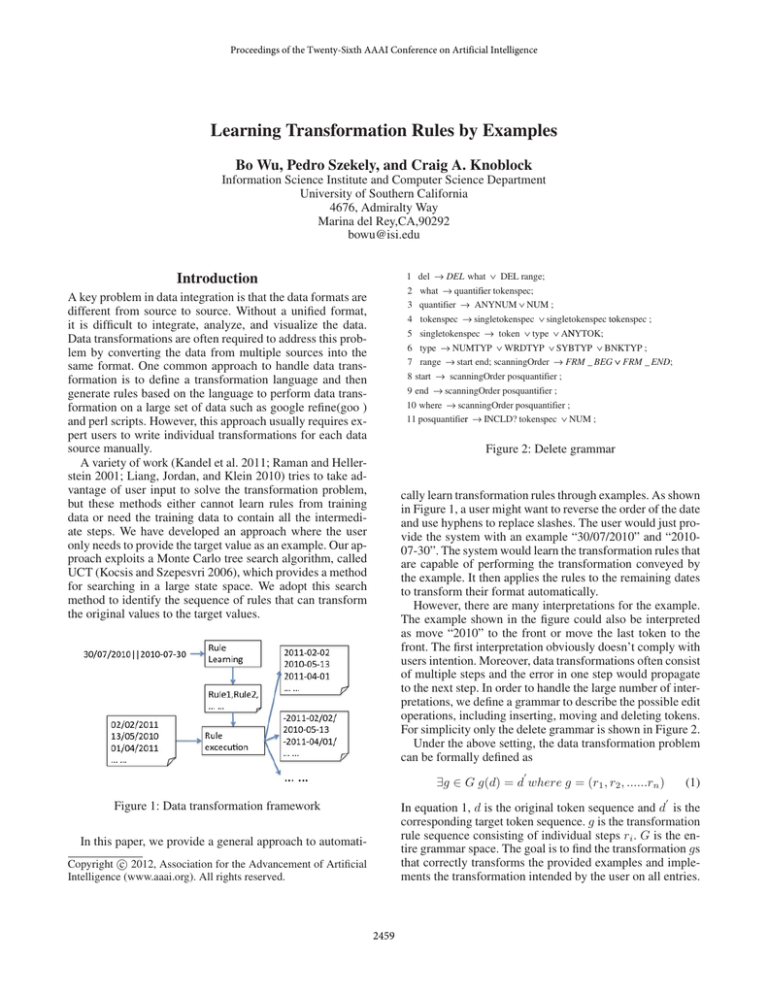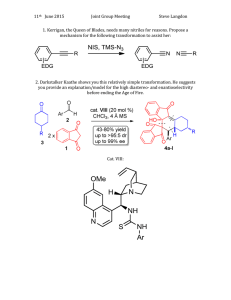
Proceedings of the Twenty-Sixth AAAI Conference on Artificial Intelligence
Learning Transformation Rules by Examples
Bo Wu, Pedro Szekely, and Craig A. Knoblock
Information Science Institute and Computer Science Department
University of Southern California
4676, Admiralty Way
Marina del Rey,CA,90292
bowu@isi.edu
Introduction
1 del → DEL what ∨ DEL range;
2 what → quantifier tokenspec;
3 quantifier → ANYNUM ∨ NUM ;
4 tokenspec → singletokenspec ∨ singletokenspec tokenspec ;
5 singletokenspec → token ∨ type ∨ ANYTOK;
6 type → NUMTYP ∨ WRDTYP ∨ SYBTYP ∨ BNKTYP ;
7 range → start end; scanningOrder → FRM _ BEG ∨ FRM _ END;
8 start → scanningOrder posquantifier ;
9 end → scanningOrder posquantifier ;
10 where → scanningOrder posquantifier ;
11 posquantifier → INCLD? tokenspec ∨ NUM ;
A key problem in data integration is that the data formats are
different from source to source. Without a unified format,
it is difficult to integrate, analyze, and visualize the data.
Data transformations are often required to address this problem by converting the data from multiple sources into the
same format. One common approach to handle data transformation is to define a transformation language and then
generate rules based on the language to perform data transformation on a large set of data such as google refine(goo )
and perl scripts. However, this approach usually requires expert users to write individual transformations for each data
source manually.
A variety of work (Kandel et al. 2011; Raman and Hellerstein 2001; Liang, Jordan, and Klein 2010) tries to take advantage of user input to solve the transformation problem,
but these methods either cannot learn rules from training
data or need the training data to contain all the intermediate steps. We have developed an approach where the user
only needs to provide the target value as an example. Our approach exploits a Monte Carlo tree search algorithm, called
UCT (Kocsis and Szepesvri 2006), which provides a method
for searching in a large state space. We adopt this search
method to identify the sequence of rules that can transform
the original values to the target values.
Figure 2: Delete grammar
cally learn transformation rules through examples. As shown
in Figure 1, a user might want to reverse the order of the date
and use hyphens to replace slashes. The user would just provide the system with an example “30/07/2010” and “201007-30”. The system would learn the transformation rules that
are capable of performing the transformation conveyed by
the example. It then applies the rules to the remaining dates
to transform their format automatically.
However, there are many interpretations for the example.
The example shown in the figure could also be interpreted
as move “2010” to the front or move the last token to the
front. The first interpretation obviously doesn’t comply with
users intention. Moreover, data transformations often consist
of multiple steps and the error in one step would propagate
to the next step. In order to handle the large number of interpretations, we define a grammar to describe the possible edit
operations, including inserting, moving and deleting tokens.
For simplicity only the delete grammar is shown in Figure 2.
Under the above setting, the data transformation problem
can be formally defined as
0
∃g ∈ G g(d) = d where g = (r1 , r2 , ......rn )
(1)
0
Figure 1: Data transformation framework
In equation 1, d is the original token sequence and d is the
corresponding target token sequence. g is the transformation
rule sequence consisting of individual steps ri . G is the entire grammar space. The goal is to find the transformation gs
that correctly transforms the provided examples and implements the transformation intended by the user on all entries.
In this paper, we provide a general approach to automatic 2012, Association for the Advancement of Artificial
Copyright Intelligence (www.aaai.org). All rights reserved.
2459
Methodology
Subgrammar Space
Dataset
50 beoaddr
50 address
50 date
50 tel1
50 tel2
50 time
50 data2
As mentioned above, the goal is to find rule sequences that
are consistent with all examples. Therefore, the search space
would be (INS)*(MOV)*(DEL)*. In this formula, the data
transformation task is divided into three phases. The first
phase consists of an undetermined number of insert operations that insert the missing tokens in the original token sequence. The second phase consists of an undetermined number of move operations that change the order of the tokens
to conform with the target token sequence. The third phase
consists of an undetermined number of delete operations that
remove the extra tokens.
The grammar space is very large. We introduce subgrammar spaces to reduce the search space into several
smaller search spaces. The entire grammar space is reformulated as a disjunction of clauses where each clause
corresponds to one subgrammar space. A subgrammar
space is a space consisting of a fixed number of edit
operations. Each edit operation itself is a grammar like
the delete grammar defined in Figure 2. But each operation has some pre-built parse trees for certain nonterminals, which are derived from token sequences aiming to further reduce the grammar space. The subgrammar
spaces for the example in Figure 1 could be written as
(IN S11 IN S12 M OV13 M OV14 M OV15 M OV16 DEL71 ) ∨
((IN S21 IN S22 M OV23 M OV24 M OV25 DEL62 )) ∨ ......
In order to generate a subgrammar space, first we generate edit operations for each individual example. The edit sequences with a length and edit type shared by all examples
are used to set the length and edit type for a subgrammar
space. Secondly, we generate candidate values for a set of
non-terminals to further reduce the grammar space. The edit
operation sequences of different examples that correspond
to the same grammar space are used to generate these candidate value set.
Table 1: Experiment Results
Examples
Time
Correct rules
2
(0.25, 0.41)
(1, 9)
(5, 6)
(0.19, 0.43)
(1, 3)
(1, 3)
(3.40, 6.23)
(1, 3)
1
(0.03, 0.06)
(97, 142)
1
(0.47, 0.74)
(19, 31)
(1, 2)
(1.08, 4.80)
(1, 8)
1
(2.80, 3.49)
(1, 3)
the search depth is 3. Initially, one entry is randomly chosen
as an example for the system to learn rules. If all generated
rules fail on the test data, an incorrectly transformed entry
together with its transformed result are added as a new example. This process iterates until finding a rule sequence,
which could transform all the entries correctly.
The above experiment is run 15 times. In Table 1, the example count shows the minimal and maximal number of examples used during 15 runs. Time cost shows the min and
max time in seconds used to learn the rules from examples.
Correct rules show the min and max number of learned correct rules. The preliminary results show correct rules for the
above scenarios can be learned in a few seconds.
Conclusion
In this paper, we presented an approach that can learn transformation rules from examples. These rules are then used
to transform the remaining data. In order to tackle the large
grammar space, a subgrammar space is introduced to reduce
the search space and a search algorithm is adopted to search
in these subgrammar spaces for a sequence of rules that is
consistent with the examples. Our preliminary results show
this approach is very promising. Future work will focus on
accelerating the search algorithm and expanding the coverage.
Search
For each subgrammar space, we use the UCT algorithm to
identify a rule sequences that is consistent with the examples. For each edit component in a subgrammar space, due
to large number of possible rules, a subset of rules is sampled
for this edit component. Each rule leads the current state into
the next state. These candidate states are evaluated and the
one with minimum score is chosen to be explored further.
The algorithm then samples the same number of rules for
this new state. This process iterates until reaching a predefined depth or reaching the last edit component of the subgrammar space. The algorithm outputs the path that leads
from the root state to the target leaf state as a transformation
rule that is consistent with the examples.
References
Google Refine http://code.google.com/p/google-refine/.
Kandel, S.; Paepcke, A.; Hellerstein, J.; and Heer, J. 2011.
Wrangler: interactive visual specification of data transformation scripts. In Proceedings of the 2011 annual conference on Human factors in computing systems, CHI ’11,
3363–3372.
Kocsis, L., and Szepesvri, C. 2006. Bandit based montecarlo planning. In In: ECML-06. Number 4212 in LNCS,
282–293. Springer.
Liang, P.; Jordan, M. I.; and Klein, D. 2010. Learning programs: A hierarchical Bayesian approach. In International
Conference on Machine Learning (ICML).
Raman, V., and Hellerstein, J. M. 2001. Potter’s wheel: An
interactive data cleaning system. In Proceedings of the 27th
International Conference on Very Large Data Bases, VLDB
’01, 381–390.
Experiment
The dataset contains 7 transformation scenarios with 50 entries and corresponding transformed results. These scenarios
include a combination of insert, move, and delete operations.
For each subgrammar space, the search algorithm is run 200
times. The number of rules sampled for each state is 6 and
2460


